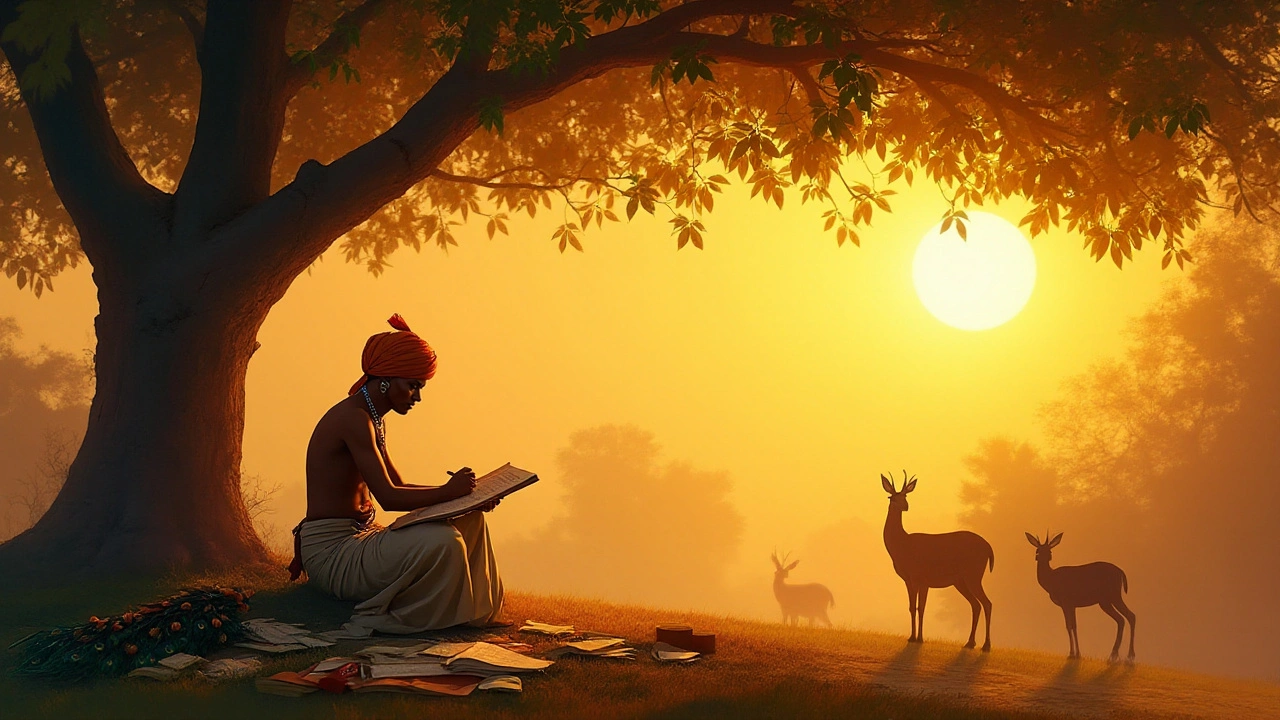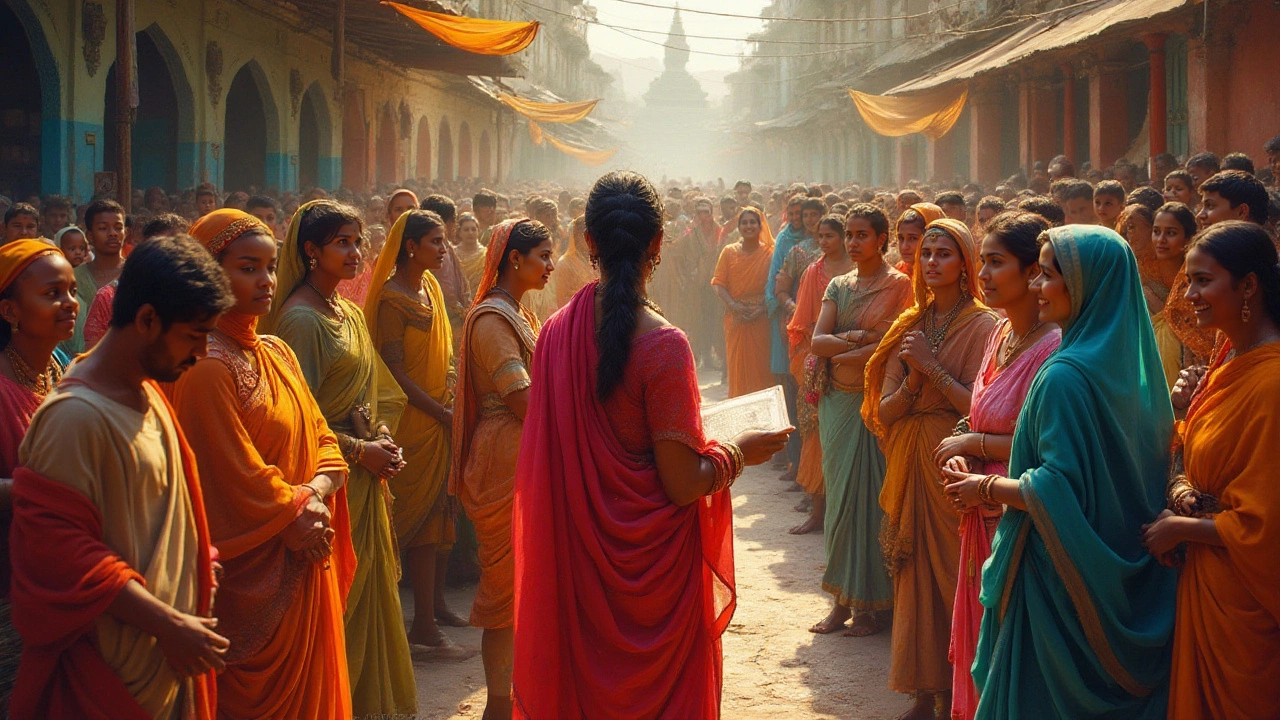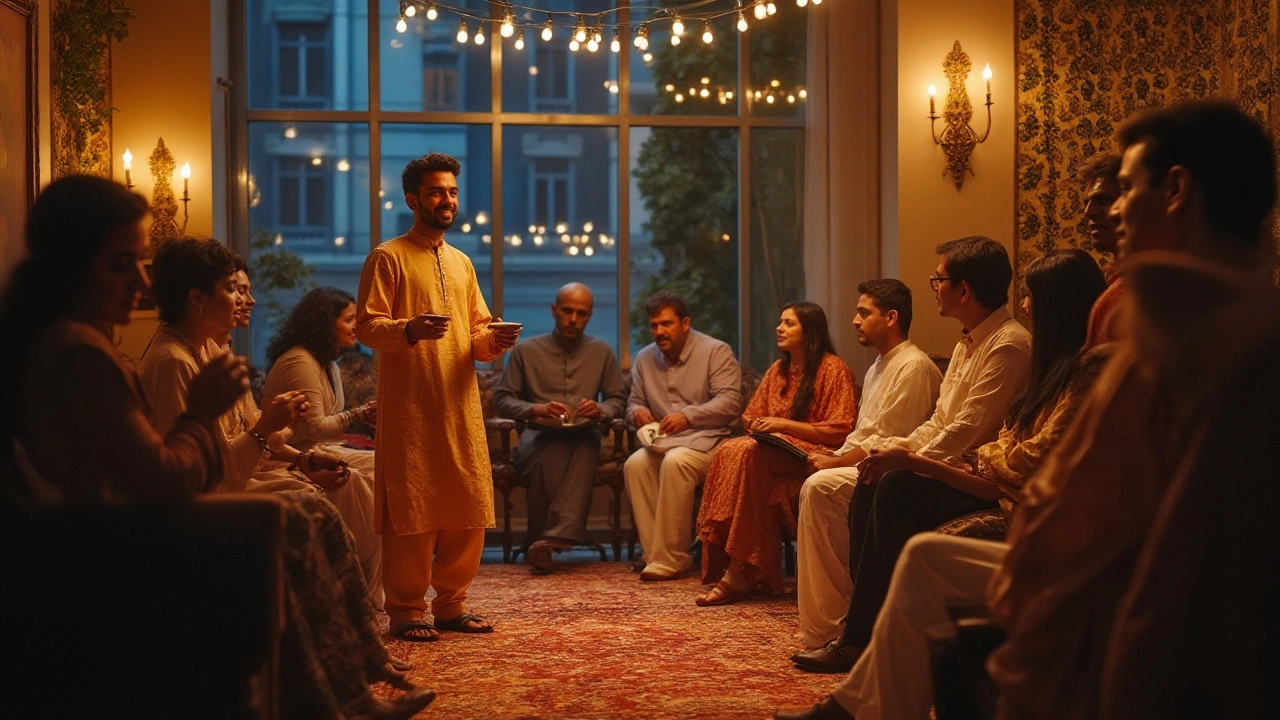Discovering India's Greatest Poet: A Journey Through Time
 Jan, 5 2025
Jan, 5 2025
India, with its deep-rooted cultural heritage and diverse traditions, has long been a land of poets and storytellers. The avenue of Indian poetry is as old as the civilization itself, echoing the voices of sages, mystics, and philosophers through the ages. From the ancient verses of the Vedas to the poignant expressions of the Bhakti and Sufi poets, the quest to identify India's greatest poet is as complex as the country's history itself.
In the heart of this exploration lies the acknowledgment of poetry's role in not just reflecting societal ethos but shaping it. Each era has crowned its own stalwarts, be it Valmiki and Kalidasa in ancient times or Rabindranath Tagore and Sarojini Naidu in the more recent past. The beauty of Indian poetry lies in its intricate tapestry of languages and styles, each offering a unique perspective on life and spirituality.
- A Historical Overview of Indian Poetry
- Ancient and Medieval Poets of India
- Impact of Colonial Era on Indian Poetry
- Prominent Modern Indian Poets
- The Symbolism and Themes in Indian Poetry
- Cultural Impact and Legacy of Indian Poets
A Historical Overview of Indian Poetry
The journey of Indian poetry spans over thousands of years, beginning with the ancient Vedas, which are some of the earliest known religious texts in the world. These hymns and chants, though primarily spiritual in nature, laid the foundation for the literary traditions that would follow. Indian poetry, from its very inception, was not just about the aesthetics of language but was deeply intertwined with the spiritual and cultural ethos of its time. As this tradition evolved, it branched into various forms, such as the epic narratives of the Mahabharata and the Ramayana, which are celebrated not just for their storytelling but for their poetic prowess.
During the classical period, Indian poets began experimenting with form and language. One of the brightest stars of this era was Kalidasa, often hailed as the 'Shakespeare of India'. His works, including 'Shakuntala' and 'Meghaduta', are quintessential examples of Sanskrit poetry, resonating with timeless beauty and emotion. This period also witnessed the blossoming of Tamil literature, with the 'Sangam' poetry that offered a window into ancient South Indian life and culture. The Bhakti movement, spanning from the 7th to the 17th centuries, brought a fresh wave of devotional poetry, emphasizing personal devotion over ritualistic practices. Saints like Kabir and Mirabai used vernacular languages to make their poetic expressions accessible to the common man.
The richness of Indian poetry can hardly be overstated. According to A.K. Ramanujan, "A poem is an affair of a whole soul, not a mere jumble of words." This holistic view underlines how poetry has been at the heart of Indian culture and history.
Poetry in India saw a significant transformation during the colonial era. English influence inspired poets like Rabindranath Tagore, who blended Western literary themes with Indian sensibilities. Tagore's deft command over language earned him the Nobel Prize in 1913, making him one of the first non-Europeans to achieve such accolades. His most famous work, 'Gitanjali', is a collection of deeply spiritual poems that continue to inspire readers around the globe. The struggle for independence also birthed a wave of patriotic poetry, with verses that stirred the nation to fight colonial rule.
Post-independence, Indian poetry continued to innovate, carving its niche beyond borders. Modern Indian poets are celebrated worldwide for their unique perspectives and powerful storytelling. Writers from diverse regional backgrounds have spotlighted issues ranging from gender to caste through their compelling verses. This era has democratized poetry, allowing voices from myriad backgrounds to be heard. Apart from Tagore, poets like Sarojini Naidu and Agha Shahid Ali have left their mark by seamlessly weaving traditional Indian themes with contemporary issues.
The evolution of Indian poetry is a testament to the enduring power of words to reflect and shape human experience. Today, the world recognizes the profound impact of India's rich poetic tradition, which continues to thrive and evolve. As readers across the globe delve into the treasures of Indian poetry, they discover that it is not just an art form but a journey through India's heart and soul.
Ancient and Medieval Poets of India
The journey through India's poetry landscape begins in the ancient period, where poets like the legendary Valmiki and Vyasa crafted epic tales that continue to resonate with the readers even today. Valmiki is often hailed as the 'Adikavi' or the first poet of Sanskrit literature, renowned for composing the Ramayana, an epic that tells the life of Lord Rama. The poem isn't just a story but a reflection of the ideals and moral code that defined ancient Indian society. Similarly, Vyasa composed the Mahabharata, which is the longest epic poem ever written. These texts, while set in mythic pasts, offer timeless teachings, wrapped in lyrical verses that have influenced generations of storytellers and poets alike.
In the subsequent medieval era, poetry in India evolved with the advent of Bhakti and Sufi movements which were instrumental in weaving complex human emotions with divine love and devotion. Poets from this era like Kabir, Tukaram, and Mirabai broke the traditional barriers, writing in regional dialects accessible to the common folk, thereby democratizing poetry. Kabir, a 15th-century weaver by trade, wrote in a mix of Hindi and Punjabi, challenging religious orthodoxy and advocating a spiritual path centered on unity and harmony. His lines, often blunt and poignant, stirred the collective conscience of the masses. As one of his couplets goes, "
Do not ask a saint his caste, you should know him by his words." This insight captures the essence of Kabir's philosophy, emphasizing inner purity over superficial distinctions.
The milieu of this era was busy with numerous regional courts patronizing poets leading to a burst of creativity unseen before. Jnanpith awardee, Marathi poet Tukaram utilized an accessible style through 'Abhanga' to convey his thoughts on spiritual enlightenment and human follies. Meanwhile, in the north, Persian poet Amir Khusro, often referred to as the "Parrot of India," created verses that intermingled Persian and Hindavi, resulting in a rich confluence of cultures that defined the fabric of medieval Indian society. His inventiveness gave birth to numerous genres and significantly, popularized the ghazal form across the region.
The devotional paths taken by Mirabai in her heartfelt abhangas demonstrated a stirring spiritual rebellion, as her work unabashedly voiced her love for Lord Krishna. Her poems stand testament to a profound courage against societal norms, resonating with readers across centuries. These Indian poets of the medieval era, with their prolific vernacular traditions, imbued their writings with passionate intensity and lyrical beauty, ensuring the preservation and popularization of cultural narratives that remain influential even in modern discourse.

Impact of Colonial Era on Indian Poetry
The onset of the colonial era brought about a paradigm shift in the landscape of Indian poetry. With the British enthronement, the amalgamation of Eastern and Western literary traditions became inevitable. This intersection of cultures spawned a literary renaissance that was both challenging and invigorating. The new era offered fresh perspectives and themes, altering not just the language and style of poetry but its soul. Many Indian poets started writing in English, which was both a conscious choice and a colonial imposition. With English, poets found a new vehicle of expression, allowing them to reach a broader audience and to engage in a transcontinental dialogue. This cross-cultural fertilization significantly influenced thematic diversity, incorporating elements such as identity, alienation, and resistance.
A celebrated poet of this era was Rabindranath Tagore, who not only penned remarkable works such as "Gitanjali," but also became the first non-European to win the Nobel Prize in Literature in 1913. Tagore's mastery lay in seamlessly weaving Eastern spiritualism with Western modernity, offering profound insights into the human experience. Tagore emphasized that "Literature has a deep significance for me"—a testament to his belief in the power of poetic expression even amidst foreign domination.
Another fascinating aspect of colonial influence was the resurgence of a nationalistic spirit in Indian poetry. The resentment towards foreign rule became palpable in the works of poets like Sarojini Naidu and Bankim Chandra Chattopadhyay. Their poetry resonated with the masses, igniting the flames of rebellion and instilling pride in India’s cultural identity. More than words, their poetry became a clarion call for freedom, invoking imagery of a sovereign India free from shackles. The colonial era also inspired a generation of poets to delve deep into India's rich past, seeking solace and strength in its legendary heroes and traditions.
"Poetry of the colonial period splendidly captures the social upheaval and cultural syncretism prevalent during that era," notes renowned literary historian William Dalrymple.
This period also saw Indian poets embrace a diverse spectrum of forms and styles. The influence of Romanticism and Victorian poetry introduced new dimensions, while traditional forms like ghazals and bhajans continued to thrive alongside. This confluence led to a vibrant poetry scene characterized by hybridity and transformation. As poets transgressed linguistic and cultural boundaries, a unique Indian poetry evolved that was distinctly its own, yet reflective of its multifaceted influences. It's noteworthy how this rich interplay has set the stage for the dynamic literary landscape we witness today.
Prominent Modern Indian Poets
In the richly storied tapestry of India’s literary history, the modern era emerges as a vibrant chapter, showcasing an array of poets who have captured the nuances and complexities of contemporary life. One of the most towering figures in this landscape is Rabindranath Tagore, the first non-European Nobel laureate in Literature. His profound work, steeped in the cultural milieu of Bengal, carved pathways for introspection and the exploration of existential themes. Tagore’s poetry, often reflective and meditative, resonates with universal truths while remaining deeply rooted in Indian ethos. His timeless composition, ‘Gitanjali’, is celebrated around the globe for its lilting beauty and philosophical depth.
Another noteworthy modern poet is Kamala Das, whose audacious exploration of womanhood, love, and loneliness shook the foundations of traditional Indian patriarchal society. Writing primarily in English and Malayalam, Das's work is characterized by its powerful voice and unabashed honesty. Her autobiographical style creates an intimate connection with her readers, making her a pivotal figure in Indian feminist literature. Her autobiography, 'My Story', became a long-standing testament to her courage and creativity. In one of her famous poems, ‘An Introduction’, Das candidly confronts societal norms and personal identity.
In the realm of Hindi literature, the iconic figure of Harivansh Rai Bachchan stands prominent. Known for his poignant use of metaphors and soulful expressions, Bachchan's ‘Madhushala’ remains a seminal work, blending the philosophical with the lyrical. With an unparalleled command over the Hindi language, his poetry traverses through love, heartache, and existential musings, leaving readers spellbound with its rhythm and rhyme. His unique style has inspired generations, cementing his place as one of India’s greatest modern poets.
The Urdu language, too, has been enriched by poets like Faiz Ahmed Faiz, whose work echoed the struggles and aspirations of the common people. Faiz’s poetry, imbibed with revolutionary zeal and romanticism, continues to inspire not only Indians but poetry enthusiasts worldwide. His narrative, often set against the socio-political backdrops, injects a profound sense of hope and resistance.
“Speak, for your lips are free; speak, your tongue is still your own,” Faiz’s call to harness the power of the spoken word reverberates strongly in the corridors of literary history.
Contemporary voices such as Gulzar have further enlivened the arena of Indian poetry. Known for his ability to weave tales of everyday life into exquisite poetic expressions, Gulzar speaks to the soul of the common man. His lyrics and poems capture the simplicity and beauty of existence, resonating deeply with audiences across ages. Gulzar’s enchanting verse, often set to music, explores themes of love, loss, and longing with unparalleled eloquence.
Indian poetry in the modern era is marked not just by its diversity of voices but also by its ability to transcend boundaries of language and genre. Prominent poets have emerged from every corner of this vast country, each contributing uniquely to the mosaic that is modern Indian poetry. Their works, imbued with the spirit of their time, continue to inspire and provoke thought, reflecting the dynamic and ever-evolving narrative of India itself.

The Symbolism and Themes in Indian Poetry
Indian poetry is a vibrant mosaic woven with symbols and themes that reflect the diverse cultural tapestry of the subcontinent. One cannot talk about this form of expression without acknowledging its deep spiritual undertones, which have been a consistent theme across various poetic traditions. From the sacred hymns of the Rigveda to the devotional verses of Bhakti and Sufi saints, spirituality manifests in myriad forms, offering profound reflections on the human condition. These works often serve as guides for moral and ethical living, emphasizing the pursuit of truth and the transcendence of the soul.
The imagery of nature has held significant sway in Indian poetry as well, symbolizing both the beauty of the divine and the impermanence of life. Seasons, rivers, and mountains are not mere backdrops but active participants in the narrative, embodying various states of emotion and consciousness. For instance, Kalidasa’s work elegantly captures the monsoon as a metaphor for longing and renewal. Tagore, often celebrated as the greatest Indian poet in modern times, masterfully uses the imagery of the 'river of life' to illustrate the flow of time and existence. This connection extends to the symbolism of flora and fauna, where each element holds specific connotations rooted in age-old cultural beliefs.
Equally compelling is the theme of love, a universal theme explored with unique depth in Indian poetry. From the romantic musings of the Tamil Sangam poets to the mystical union with the divine expressed in the verses of Mirabai and Kabir, love transcends earthly boundaries, underscoring both human relationships and the soul's yearning for the divine. The Bhakti and Sufi poets, in particular, depicted love as a path to enlightenment, blending erotic and ethereal to depict a holistic approach to devotion. These themes resonate with the larger idea of unity in diversity, which is the cornerstone of India's rich cultural heritage.
The socio-political landscape has also greatly influenced Indian poetry, particularly during and after the colonial era. The struggle for independence and the quest for identity became potent subjects for poets like Subramania Bharati and Sarojini Naidu. They adeptly used poetic symbolism to voice the aspirations and frustrations of the masses, advocating for a resurgence of cultural pride and social justice. The poets of this era didn't shy away from leveraging their art as a tool for activism, infusing their verses with powerful symbols of resistance and hope.
Tagore eloquently asserted, "The highest education is that which does not merely give us information but makes our life in harmony with all existence."
This rather broad spectrum of thematic elements sets Indian poetry apart, making it a timeless and dynamic form of expression. The allegories and metaphors used in poetic compositions continue to speak to audiences across generations, resonating with their shared human experiences and aspirations. As the poetry of India evolves with contemporary themes such as environmental conservation and women's empowerment, its symbolic language remains as potent and evocative as ever, bridging the gap between traditional wisdom and modern consciousness.
Cultural Impact and Legacy of Indian Poets
Indian poets have been instrumental in weaving the cultural fabric of the subcontinent, their verses echoing across the dusty expanses and bustling cities alike. Over centuries, poetry has transcended the barriers of language and time, becoming the torchbearer of India's rich heritage and diverse cultural ethos. The greatest Indian poet, often a reflection of his or her era, has often harnessed poetry as a force for unity and self-exploration, aligning with the country's panoramic array of emotions and experiences. As India went through transformative changes, it was poets who captured the essence of evolving identities, societal reforms, and nationalistic fervor in their stanzas. Their narratives have been treasures to generations, offering both comfort and contemplation.
The impact of Indian poetry isn't limited to literary circles; it spills over into varied aspects of life. Songs of devotion, rebellion, and love voiced by poets like Kabir, Mirza Ghalib, and Rabindranath Tagore, have played pivotal roles in socio-political movements, transcending into timelessness. Kabir's dohas, known for their simplicity yet profound reflections on human nature and spirituality, have been revered universally. Ghalib, with his ghazals, opened windows to introspective musings, revealing an India grappling with its colonial existence. Each of these maestros, revered as the greatest Indian poet for different reasons, has set monumental benchmarks for literary excellence.
As once noted by Tagore, "Poetry is the language of experience." His words resonate deeply with the Indian cultural psyche, where poetry is not just about the rhymes but the deeper connection it forges with human experiences.
The legacy of these poets is etched not just in the annals of literature but in everyday life. Educational curriculums across India incorporate their works, ensuring that each new generation inherits this inexhaustible trove of wisdom and insight. The influence of Indian poets extends globally, inspiring famous international poets and writers with their versatile themes of humanism and nature. This global resonance emphasizes their universal appeal, further cementing their cultural impact. The tales woven into Indian poetry often serve as a historical timeline, capturing pivotal shifts in thought, aspirations, and fears.
The seamless synthesis of diverse regional languages in Indian poetry is another testimony to its far-reaching cultural implications. Be it Tamil saint-poet Thiruvalluvar’s ethical verses or Punjabi Sufi poet Bulleh Shah’s spiritual discourses, each poet has contributed credence to the multicolored linguistic landscape. Their verses are more than mere words; they are powerful agents of change, transcending regional lines and uniting a nation with their shared message. As we seek to divine the greatest Indian poet of all, we must acknowledge this thriving cultural legacy—a continuous lineage that propels contemporary voices, ensuring the spirit of Indian poetry remains alight.